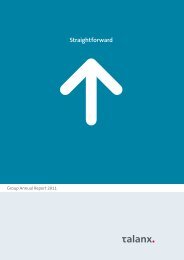Values
Values
Values
You also want an ePaper? Increase the reach of your titles
YUMPU automatically turns print PDFs into web optimized ePapers that Google loves.
1 2 3<br />
1 | The RTL morning show “Guten Morgen Deutschland,“ here with Wolfram Kons and Anja Stehmeyer, was a new addition in 1987<br />
2 | Equally spectacular: the ”Tutti Frutti“ show in 1990 with Hugo Egon Balder 3 | ”Knight Rider“ starring David Hasselhoff was<br />
the first American series on RTL Plus in August 1985<br />
and he reattached the crown with the<br />
help of some chewing gum. The programmers<br />
did not shy away from even<br />
the most basic games and contests.<br />
Hundreds of viewers call in; they had<br />
never seen television like this before.<br />
“A lot of things we did were very<br />
homespun,” admits Thoma. “But our<br />
decades of experience with live radio<br />
helped smooth the way.” Thoma’s aims<br />
were very simple. “We wanted people<br />
to watch – that’s all.” And he couldn’t<br />
really ask for anything more, as there<br />
was no money to produce features, series,<br />
or TV movies. The producers<br />
couldn’t even rely on material from the<br />
vault in the early years. “We owned only<br />
12 fi lms when we started,” says<br />
Thoma. RTL’s fi rst fi lm buyer, Erhard<br />
Puschnig, remembers having a diffi -<br />
cult time even getting his hands on<br />
fi lms. The budget allowed for no more<br />
than kitschy Italian movies or niche<br />
fi lms from France.<br />
The fi ve-member news team also<br />
had diffi culty securing good video material<br />
in the beginning. The station<br />
couldn’t afford satellite vans and reporters.<br />
For international stories, they<br />
had access to material from Eurovision,<br />
because Luxembourg was a founding<br />
member of the European Broadcasting<br />
Union. “But when it came to local stories,<br />
we rarely had any video footage,”<br />
remembers Marc Conrad, the former<br />
editor-in-chief.<br />
As RTL was unable to compete with<br />
the public broadcasters in showing images<br />
of the news, the station sought at<br />
least to get a jump on the competition<br />
when it came to broadcasting times.<br />
The daily news program was broadcast<br />
at 6:53 p.m. No other station had ever<br />
dared to deviate from the tradition of<br />
beginning broadcasts of serious programming<br />
exactly on the hour. RTL<br />
calls its 20-minute news show “7 vor 7.”<br />
And what was lacking in video footage<br />
was made up for by a creative presentation<br />
style. When it rained, attentive<br />
viewers could even hear the raindrops<br />
on the studio roof.<br />
In 1985, a fresh talent from the Henri<br />
Nannen School for Journalism moved<br />
from Gruner + Jahr to the news team:<br />
Peter Kloeppel. Kloeppel, currently editor-in-chief<br />
of RTL, looks back fondly on<br />
his early days at the station. He started<br />
work as a correspondent in Bonn. “The<br />
competition would transfer their reports<br />
to the main studio electronically,<br />
but I was sending mine by courier,” he<br />
says. “If the tapes were to be in Luxembourg<br />
on time, I had to be fi nished by no<br />
later than 4:00 p.m.” Given such constraints,<br />
why did he choose to join RTL?<br />
“I found the team really motivating, and<br />
0.4 %*<br />
1985<br />
1.3 %<br />
1987<br />
12.7 %<br />
1989<br />
VIEWER MAGNET<br />
21.2 %<br />
16.7 %<br />
1991<br />
1993<br />
RTL’s audience share development<br />
in Germany<br />
When it began, few people saw<br />
RTL’s programs. During the 90s,<br />
things changed. Source: AGF/GFK /<br />
RTL market research.<br />
* target audience age 14 - 49<br />
the presentation style of the news was<br />
fresh and modern.”<br />
This fresh approach brought the<br />
station high ratings – for its news, music<br />
and quiz shows. “Our programs<br />
weren’t there to impress us or the critics.<br />
We wanted the viewers to like us,<br />
and they noticed that,” says Conrad. In<br />
his small broadcasting region, initial<br />
surveys showed that RTL had nearly a<br />
30 percent audience share when it was<br />
on the air. Interest in advertising on the<br />
new station grew.<br />
Good contact with RTL Radio led<br />
many advertisers to RTL television. In<br />
its fi rst year, 30 seconds of ad time cost<br />
1,000 marks (500 euros). Bertelsmann<br />
was hoping to make up to 10 million<br />
marks (5 million euros). It succeeded in<br />
reaching that goal, which meant that<br />
the new station had earned around 40<br />
percent of its entire budget in the fi rst<br />
year – an enormous accomplishment.<br />
RTL retained this pioneering spirit in<br />
the years that followed. Viewers were attracted<br />
by such programs as the morning<br />
breakfast show and the daily soap operas.<br />
It wasn’t long before bare breasts<br />
(“Tutti Frutti”) and screeching cars (Formula<br />
1) were electrifying the lineup.<br />
When Boris Becker and Steffi Graf won<br />
Wimbledon in 1989, RTL had the exclusive<br />
rights to the coverage. By this time,<br />
the station was already broadcasting<br />
from Cologne. RTL was growing up.<br />
“In hindsight, the start of RTL was<br />
clever, professional, and cheap,” says<br />
Bernd Schiphorst. But in the station’s<br />
early days, the atmosphere at RTL was<br />
reminiscent of the title of the fi rst series<br />
that RTL ever broadcast: “Der ganz<br />
normale Wahnsinn,” or “Just the usual<br />
craziness.”<br />
– 21 –
















